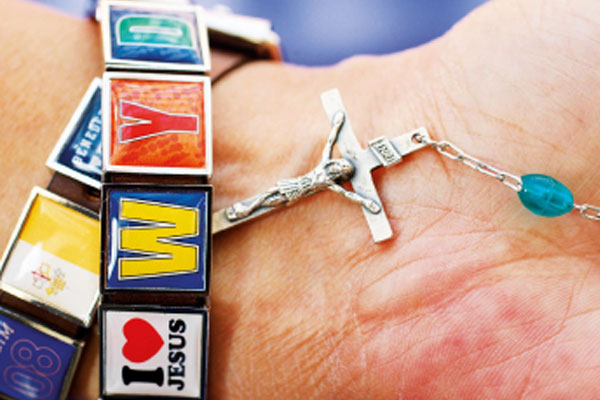Volunteering to help smooth the path of pilgrims can be nothing short of miraculous
“The Church’s fairground” – “Holy Blackpool” – “Catholic Eurovision” – and this what people who like Lourdes call it. In 1858, Bernadette Soubirous saw 18 visions of Our Lady in a cave on the shabby, flood-prone fringe of a remote Pyrenean town. A century-and-half later, that cave is the fulcrum of a pious urban sprawl, with churches and shrines and mass-catering hotels and gift shops and an airport, all to accommodate the millions of pilgrims who have come here since. On my first night here with the Diocese of Westminster pilgrimage, still dizzy from the 4 a.m. departure, we walked along the back wall of the grotto, stroking a waist-height band of mountain rock worn pebble-smooth by generations doing the same.
You hear a lot about Lourdes: the apparitions, the miracles, the kitsch. What you actually hear in Lourdes is music, almost constantly, whether you like it or not. Even the basilica bell chimes to the tune of “Immaculate Mary”. At any moment pilgrim groups in the domaine – the area around the grotto – will have three or four renditions of “Ave Maria” on the go, none quite synchronised with the others. Discreet chapels suddenly reveal themselves with peals of hymns in Dutch and Korean. The shimmering holy medal shops pipe versions of those hymns back to souvenir-hunters. As I write, in the dining room downstairs, a French pilgrimage has just struck up a choral if not-quite-tuneful grace before dinner.
The variety is catholic bordering on the cacophonous. Hymns solemn and blood-curdling or the happiest of clappy; a deafening organ voluntary followed by a Basque folk band; bagpipes in the hospital foyer. If you attempt to be discerning – or snobbish – you’ll trip up. I may not have liked “Sing it in the valleys” when we learnt it at primary school, but it is now part of our common Catholic patrimony and if you know the words you’ll find yourself singing (even if you pretend it’s ironic) and understanding the point of the song. One afternoon, as the clergy smoothed a rain-affected outdoor Mass towards a prompt-but-dignified conclusion so we could evacuate the wheelchairs off the mountainside, the choir struck up “Our God Reigns” and everybody laughed and cheered up, though somebody had to explain the joke to me.
At a tea party, I had a chat with a bishop who had said Mass that morning for the handicapped children of the pilgrimage. “We had the clap-clap Gloria,” he said, “which isn’t my favourite, but when you saw how the children joined in you realised what it’s for.” Lots of things reveal their unaffected purpose this way. The subterranean Basilica of Pope Pius X is compared by its critics to an underground car park (quite unfairly – it’s more like the War Room in Dr Strangelove) but the heaving International Mass on Sunday – where the Eurovision moniker certainly applies – showed the architecture at work, monumental concrete giving all the thousands present an unimpeded view of the altar. Its construction had less to do with highfalutin liturgical concerns than the need for somewhere to keep the Blessed Sacrament procession out of the rain.
The exotic outfits on display have similarly sensible explanations. People who work in the domaine (called brancardiers – “stretcher-bearers”) wear rather flashy straps over their shoulders, which today serve as their badge of office but were originally used to hold stretchers. They are no less useful now for identifying somebody to help you with a wheelchair. Even the tat shops have their role: Lourdes is a remote town with little employment to offer – the shocking poverty in which St Bernadette’s family lived was partly a product of this mountainous, even desolate situation. Today, it’s those tasteless shops which allow its inhabitants to make a living and keep the place alive for pilgrims. (Our Lady knew what she was doing when she appeared there, though it can be hard to think that when you’re pushing a wheelchair up a 20-degree incline.) Lourdes doesn’t go in for symbolism: it’s about brass tacks and the supernatural and not much in between.
I am here as one of the helpers in the Accueil Marie Saint Frai, which provides hospital accommodation for disabled pilgrims. While there is valuable time for reflection built into the military schedule of devotions and mealtimes, I have found that the hard graft itself reveals the meaning most directly. We wryly exclaim “It’s a Lourdes miracle!” when a coffee machine works or a recalcitrant pilgrim makes it to breakfast in time. But it really is miraculous that we are all here in spite of circumstance and difficulty, making coffee and eating breakfast and doing simple things in an extraordinary place. Our job in the Saint Frai, as the organisers explained at the start, is to give the residents the best possible holiday and leave any profundities to them. I hope that they have enjoyed it; I have, in the meantime, had the best week of my year.
To download the latest issue of inspire, click here



 Loading ...
Loading ...
What do you think?
You can post as a subscriber user ...
User comments (0)